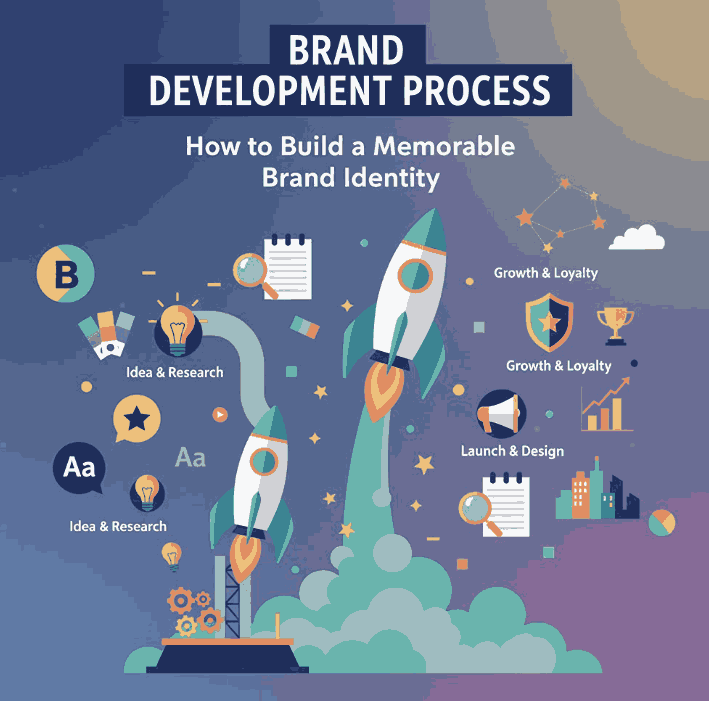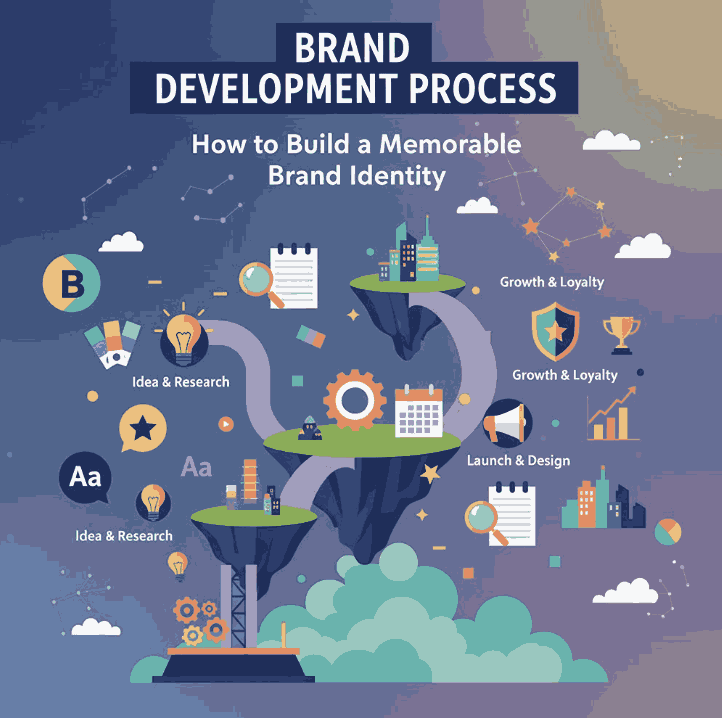
Table of Contents
- Introduction
- What Is Brand Development?
- The Importance of a Strong Brand
- Step-by-Step Brand Development Process
- Step 1: Research and Analysis
- Step 2: Define Your Brand Identity
- Step 3: Create Your Visual Branding
- Step 4: Develop a Consistent Brand Voice
- Step 5: Implement and Monitor Your Brand
- Best Practices for Effective Brand Building
- Font Inspiration for Your Brand Design
- Conclusion
- References
1. Introduction
In today’s competitive market, a strong brand isn’t just about having a great logo or catchy slogan—it’s about building trust, recognition, and emotional connection. The brand development process helps transform your business from a simple idea into a recognizable identity that resonates with your target audience.
Whether you’re a startup or a growing company, understanding how to strategically develop your brand is the foundation for long-term success.

2. What Is Brand Development Process?
Brand development refers to the strategic process of creating and strengthening your brand identity. It combines research, creativity, and consistency to establish a clear message and visual style that communicates who you are and what you stand for.
It’s not just about your logo or color palette—it’s about how people perceive your company. A well-developed brand conveys professionalism, trustworthiness, and authenticity.
3. The Importance of a Strong Brand Development Process
A strong brand offers several advantages:
- Builds customer trust and loyalty.
- Differentiates your business from competitors.
- Increases brand recall and recognition.
- Supports consistent marketing strategies.
- Boosts long-term profitability.
A clear brand identity ensures that your audience immediately recognizes and connects with your values, products, and message.
4. Step-by-Step Brand Development Process
Step 1: Research and Analysis
Begin by understanding your market, audience, and competitors. Conduct:
- Market analysis to identify trends.
- Audience profiling to define customer personas.
- Competitor audits to spot opportunities.
Research gives direction and ensures that your brand’s foundation is built on data, not assumptions.
Step 2: Define Your Brand Identity
This includes defining:
- Mission and vision – what your brand stands for.
- Core values – what principles guide your brand’s behavior.
- Unique selling proposition (USP) – what sets you apart.
Your identity should reflect your tone, style, and promise to customers.
Step 3: Create Your Visual Branding
Your brand’s visual elements—logo, colors, typography, and imagery—are what people notice first. Each element must be consistent with your message and emotional tone.
Here are some beautiful font inspirations from CalligraphyFonts.net that can enhance your brand visuals:
- Charima Sharene Font – Elegant and feminine, perfect for fashion or lifestyle brands.
- Rustte Font – Bold and dynamic, ideal for branding with a strong personality.
- Catcalling Font – Playful and handwritten, great for creative businesses.
- Jalousie Font – Classy and refined, suitable for premium or boutique brands.
Step 4: Develop a Consistent Brand Voice
Your brand voice is how you communicate. Whether it’s formal, friendly, or witty, your tone should match your brand identity and be consistent across platforms—website, emails, packaging, and social media.
A clear, consistent voice helps build emotional connection and recognition.
Step 5: Implement and Monitor Your Brand
Once your branding is complete, it’s time to roll it out. Apply your logo, fonts, and color schemes across all materials—digital and physical.
Regularly monitor brand performance through:
- Social media engagement
- Customer feedback
- Brand awareness surveys
Adapt and evolve your strategy as your market changes.

5. Best Practices for Effective Brand Building
- Be authentic—people connect with genuine stories.
- Keep your visuals consistent.
- Prioritize customer experience.
- Evolve your brand with feedback.
- Stay true to your mission and values.
Branding is not a one-time task; it’s an ongoing commitment to your audience.
6. Font Inspiration for Your Brand Design
Typography plays a major role in shaping brand perception. The right font can elevate your logo, website, and product design.
Explore the full collection of handcrafted fonts at CalligraphyFonts.net to find typefaces that bring your brand to life.
7. Conclusion
The brand development process is the foundation of every successful business. It’s about more than visuals—it’s about creating a unified experience that inspires trust, loyalty, and recognition.
By combining strategy, creativity, and consistency, your brand can stand out and leave a lasting impression.
Start building your identity today with the right fonts and design tools to express your unique story.
8. References
- Canva — The Essential Guide to Branding
- Wikipedia — Brand (encyclopedic background and references)
- Din Studio — 4 Simple Steps to Build Branding



